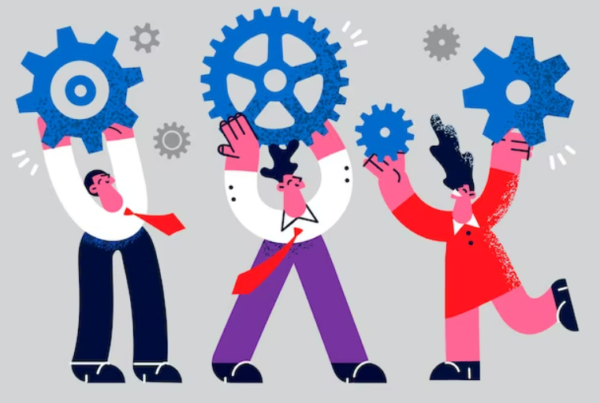Many firms are striving to recover control and routine with teams and people operating in numerous places as the world of work continues to shift post-COVID-19.
As workers settle into new routines, managers are looking for new methods to engage, empower, and motivate their employees in order to improve organizational trust and productivity.
A trust-based organizational culture has a significant impact on how employees bounce back, re-engage, and increase their productivity at work. Employees want to know that their teams value them through difficult times. They want their opinions to be heard, and they want to know that the organizations for which they work are looking out for their best interests.
Employees feel insecure and uncertain in their jobs and prospects with an employer when conditions change, like as the now-deescalating epidemic. When opposed to an organization whose employees don’t know where they stand, one that takes steps to assure its personnel of an ongoing commitment to its aims and values will reap enormous rewards.
Why is it important to have trust at work?
According to studies, companies with high-trust cultures have a higher financial success rate than those without. Employees in high-trust firms report: When compared to individuals in low-trust situations, in a deep dive into the neurobiology of trust in organizational culture, employees in high-trust companies report:
- At work, you’ll have 106 percent more energy.
- 76 percent more participation
- 74 percent less anxiety
- Increased productivity by 50%
- Overall, there is 40% less burnout.
- They are more satisfied with their lives by 29%.
- There were 13% fewer sick days.
When it comes to why trust at work matters, these benefits are just the top of the iceberg. Work disagreements, missed deadlines, cooperation challenges, and even marketing and communication errors are all caused by a lack of team trust.
Building trust in teams has never been more important for an organization’s survival and growth, especially when most employees operate remotely for the first time. Workplace trust fosters a productive environment that results in high-quality outputs and increased profits.
Recognizing the stages of team formation
Team building has an impact on how employees interact with one another both on and off the job. Your company may be fortunate in attracting and retaining high-performing employees, but if they can’t work together, long-term retention becomes challenging.
Strong teams follow a pattern of growth, becoming more prolific and productive over time. Managers that understand this may lead their teams to a culture of trust, innovation, and feedback, creating a safe environment where employees can learn and share ideas without fear of being judged.
Researchers Bruce Wayne Tuckman and PhD student Mary Ann Jensen put together the following five stages of team building. These stages of team development lay forth a path for developing collaborative, high-trust, and high-performing groups.
There are five steps to developing a team
Forming: Members of the team are introduced. This first meeting should be facilitated by managers and team leaders, who should highlight each team member’s background and experience. Important organizational information, new project specifics, and the opportunity to ask questions about their job and get to know team members may also be shared with team members.
Storming: As team members grow to know each other and their roles and positions better, they discuss and listen to ideas. Team leaders and managers can help with this stage by creating team building activities that stimulate team bonding and competitiveness, as well as breaking the ice with communication, problem-solving, and creative games. As team members try to curry favor for their recommendations, opinions, and perspectives on how to get things done inside the team, this stage may result in some personality clashes and confrontations. It’s possible that members will differ over how to execute a task or project. It’s crucial to realize that teams have disagreements. Assist team members in achieving great results and ensuring that everyone is focused on completing the goals or tasks at hand.
Norming: Members of the team become accustomed to working together. Each person’s goals and responsibilities should be clear at this point. Managers and team leaders must describe the company’s systems and processes. Processes for discussing project-related concerns, resolving problems, assessing and approving work, and synchronizing cross-functional collaboration are all part of this.
Performing: Members of the team collaborate and work as a unit. Between team members and teams, there is a growing level of trust and togetherness. With protocols in place and minimal scrutiny from supervisors, employees are performing at optimum efficiency. Snags, scheduling conflicts, and other challenges may arise, but team members have ways for resolving them without jeopardizing project timetables and progress.
Team members finish their projects and meet to discuss what went well and what needs to be improved for future project planning and execution.
As a leader, how do you develop trust in your team?
How you develop trust in your team as a leader has an impact on how members operate. High-trust leaders foster trust through establishing and expressing clear directives, as well as providing teams with the resources they require to complete their duties.
Low-trust managers take on the additional responsibility of micromanaging their employees in order to boost productivity and hours worked, thereby eroding trust. Instead, effective team leaders should establish clear processes and workflows that allow jobs and projects to be completed without the need for repeated check-ins, interruptions, or supervision.
Here are seven helpful steps for leaders and managers to adopt to establish trust in their teams, all of which are validated by team building science:
Encourage bonding
With team building trust exercises, you may strengthen interpersonal interactions between teams and employees. This helps to remove silos, friendship cliques, and office politics, all of which can stifle team collaboration. Organization-wide bonding methods, such as appointing peer pals and department mentors, also aid in the reduction of a us vs. them mentality among teams and their supervisors.
Consistency is important
Maintain consistency by ensuring that the leadership and management teams carry out their commitments. If a change of plan or tactics is required, make sure to keep team members informed, even if it means explaining the reasoning behind the decisions. This fosters a culture of trust, where employees believe in the organization’s mission and the value of their work.
Create processes
To escape the temptation of micro-managing teams and projects, establish a clear method for giving and receiving reviews, as well as assuring remote job accountability. Clear procedures define requirements, standards, and expected outcomes so that everyone in the team understands what they need to do and when they need to do it.
Give kudos
Regardless of their position or function on the team, give recognition and respect to those who deserve it. Recognition has the biggest positive influence on trust when it occurs immediately after a goal is reached, when it comes from leaders, and when it’s tangible, unexpected, personal, and public, according to neuroscience. Using the power of the crowd to celebrate successes, keep progress transparent, and inspire other team members to strive for excellence, recognizing excellent performance within your teams uses the power of the crowd to celebrate successes, keep progress transparent, and inspire other team members to strive for excellence.
Allow autonomy
Allow folks to perform their work in their own way. Allowing your team to have varying levels of autonomy allows each individual to make decisions and take risks within their function in order to perform tasks and meet the organization’s objectives. Give your team members more freedom to execute projects their way after they’ve completed training. Trusting your people to accomplish their duties stimulates and encourages them to think outside the box.
Communicate frequently
Disseminate information widely and openly. Keep your staff informed about any changes to the projects they’re working on. Uncertainty regarding the firm’s direction can cause stress and burnout, so keep your employees informed about any corporate changes or efforts. They should first hear about them from the executive team. Because they are included, your employees become ambassadors, understanding and believing in the company’s mission and actions.
Invest in your people
Finally, high-trust workplaces support their employees’ complete development. When it comes to growing talent within the organization, they have a development mindset, setting out time for managers and direct reports to meet and discuss overall growth, which encompasses both professional and personal goals. Organizations that invest in their people are more likely to retain talent and improve employee engagement.
So there you have it: seven stages to establishing trust in a group. Each stage encourages managers and team members to take on greater responsibilities in their roles, participate in the organization’s activities, and give their all every time they get the opportunity.
To get things started, do some team-building exercises to develop trust.
You have a variety of possibilities for team building trust exercises depending on your post-pandemic work structure. Whether your teams operate in the office, remotely, or in a hybrid arrangement will influence your decision.
Building team trust has a lot of advantages. You want employees to feel comfortable making decisions and taking chances that benefit the company. You’ll need processes and practices that encourage teamwork and collaboration with others. You should also make sure that the digital systems and tools you use to do job activities have a high level of security.
Implement a trust-building plan that includes measures of clarity, consistency, and quality control.
Clarity: Outline your organization’s major objectives and priorities to ensure that teams are on the same page in terms of their aims and contributions. Employees perform more efficiently when they understand where the organization is headed and what role they will play. Wrike has a central dashboard with critical analytics, notifications, and an activity stream that keeps team members on track. Multiple project views, including Gantt charts, provide a rapid overview of project status and schedules.
Consistency: Teamwork succeeds when members have faith in one another to deliver and match their efforts with quality and enthusiasm. When there is trust at work, everyone relies on the others to put in constant effort and deliver solid outcomes on a regular basis. Wrike allows teams to collaborate and contribute to projects using standard and customizable workflows. The software also includes review and approval features to ensure that each team member’s work is always up to par.
Communication: This is vital for a high-trust team. It must be honest, safe, and transparent. There is more trust and productivity when team members know they can readily contact others to address difficulties or obtain answers to queries.




